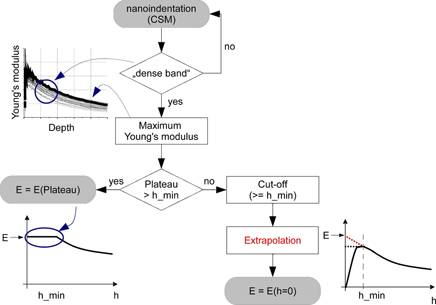Crossref Citations
This article has been cited by the following publications. This list is generated based on data provided by
Crossref.
Gibson, Ronald F.
2014.
A review of recent research on nanoindentation of polymer composites and their constituents.
Composites Science and Technology,
Vol. 105,
Issue. ,
p.
51.
Low, Teck Fei
Pun, Chung Lun
and
Yan, Wenyi
2015.
Theoretical study on nanoindentation hardness measurement of a particle embedded in a matrix.
Philosophical Magazine,
Vol. 95,
Issue. 14,
p.
1573.
Yan, Z.
Wilkinson, S. K.
Stitt, E. H.
and
Marigo, M.
2015.
Discrete element modelling (DEM) input parameters: understanding their impact on model predictions using statistical analysis.
Computational Particle Mechanics,
Vol. 2,
Issue. 3,
p.
283.
Amanieu, Hugues-Yanis
Aramfard, Mohammad
Rosato, Daniele
Batista, Leonardo
Rabe, Ute
and
Lupascu, Doru C.
2015.
Mechanical properties of commercial LixMn2O4 cathode under different States of Charge.
Acta Materialia,
Vol. 89,
Issue. ,
p.
153.
Dragatogiannis, D. A.
Perivoliotis, D. K.
Karagiovanaki, S.
Zoumpoulakis, L.
and
Charitidis, C. A.
2016.
Effect of magnetite particle loading on mechanical and strain sensing properties of polyester composites.
Meccanica,
Vol. 51,
Issue. 3,
p.
693.
Haušild, Petr
Materna, Aleš
Kocmanová, Lenka
and
Matějíček, Jiří
2016.
Determination of the individual phase properties from the measured grid indentation data.
Journal of Materials Research,
Vol. 31,
Issue. 22,
p.
3538.
Wilkinson, S.K.
Turnbull, S.A.
Yan, Z.
Stitt, E.H.
and
Marigo, M.
2017.
A parametric evaluation of powder flowability using a Freeman rheometer through statistical and sensitivity analysis: A discrete element method (DEM) study.
Computers & Chemical Engineering,
Vol. 97,
Issue. ,
p.
161.
Argatov, Ivan I.
and
Sabina, Federico J.
2017.
A two-phase self-consistent model for the grid indentation testing of composite materials.
International Journal of Engineering Science,
Vol. 121,
Issue. ,
p.
52.
Čech, Jaroslav
Haušild, Petr
Karlík, Miroslav
Kadlecová, Veronika
Čapek, Jiří
Průša, Filip
Novák, Pavel
le Bourhis, Eric
Habraken, Anne
Mertens, Anne
Vitry, Véronique
and
Colla, Marie-Stéphane
2019.
Mechanical properties of FeAlSi powders prepared by mechanical alloying from different initial feedstock materials.
Matériaux & Techniques,
Vol. 107,
Issue. 2,
p.
207.
Luo, Shengmin
Lu, Yunhu
Wu, Yongkang
Song, Jinliang
DeGroot, Don J.
Jin, Yan
and
Zhang, Guoping
2020.
Cross-scale characterization of the elasticity of shales: Statistical nanoindentation and data analytics.
Journal of the Mechanics and Physics of Solids,
Vol. 140,
Issue. ,
p.
103945.
Argatov, Ivan I.
and
Sabina, Federico J.
2020.
Contact stiffness indentation tomography: Moduli-perturbation approach.
International Journal of Engineering Science,
Vol. 146,
Issue. ,
p.
103175.
Lu, Yunhu
Li, Yucheng
Wu, Yongkang
Luo, Shengmin
Jin, Yan
and
Zhang, Guoping
2020.
Characterization of Shale Softening by Large Volume-Based Nanoindentation.
Rock Mechanics and Rock Engineering,
Vol. 53,
Issue. 3,
p.
1393.
Sousa, Bryer C.
Gleason, Matthew A.
Haddad, Baillie
Champagne, Victor K.
Nardi, Aaron T.
and
Cote, Danielle L.
2020.
Nanomechanical Characterization for Cold Spray: From Feedstock to Consolidated Material Properties.
Metals,
Vol. 10,
Issue. 9,
p.
1195.
Luo, Shengmin
Kim, Daeyoung
Wu, Yongkang
Li, Yucheng
Wang, Dongfang
Song, Jinliang
DeGroot, Don J.
and
Zhang, Guoping
2021.
Big Data Nanoindentation and Analytics Reveal the Multi-Staged, Progressively-Homogenized, Depth-Dependent Upscaling of Rocks’ Properties.
Rock Mechanics and Rock Engineering,
Vol. 54,
Issue. 3,
p.
1501.
Luo, Zhongcan
Ye, Zhanwen
Duan, Bo
Li, Guodong
Li, Kaiyuan
Yang, Zijian
Nie, Shiqing
Chen, Tianwei
Zhou, Ling
and
Zhai, Pengcheng
2022.
SiC@BaTiO3 core-shell fillers improved high temperature energy storage density of P(VDF-HFP) based nanocomposites.
Composites Science and Technology,
Vol. 229,
Issue. ,
p.
109658.
Ying, Pengfei
and
Xia, Yong
2023.
Elastic modulus identification of particles in particulate composite through nanoindentation.
International Journal of Mechanical Sciences,
Vol. 260,
Issue. ,
p.
108660.
Lou, Hao
Ding, Li
Wu, Tian
Li, Weikun
Khalaf, Ryan
Smyth, Hugh D. C.
and
Reid, Darren L.
2023.
Emerging Process Modeling Capabilities for Dry Powder Operations for Inhaled Formulations.
Molecular Pharmaceutics,
Vol. 20,
Issue. 11,
p.
5332.
Mathiyalagan, Sribalaji
Rossetti, Matteo
Björklund, Stefan
Basu, Soudip
Balila, Nagamani Jaya
Sowers, Susanne
and
Joshi, Shrikant
2024.
Deposition characteristics and tribological performance of atmospheric plasma sprayed diamond metal matrix composite (DMMC) coatings.
Materials Chemistry and Physics,
Vol. 315,
Issue. ,
p.
128920.
Rösemeier-Scheumann, René
Wagner, Lars
Bobe, Ulrich
Bozon, Annabel
Kwade, Arno
and
Finke, Jan Henrik
2024.
Structural and functional analysis of a new co-processed tableting excipient for food compaction processes.
Journal of Food Engineering,
Vol. 363,
Issue. ,
p.
111624.



